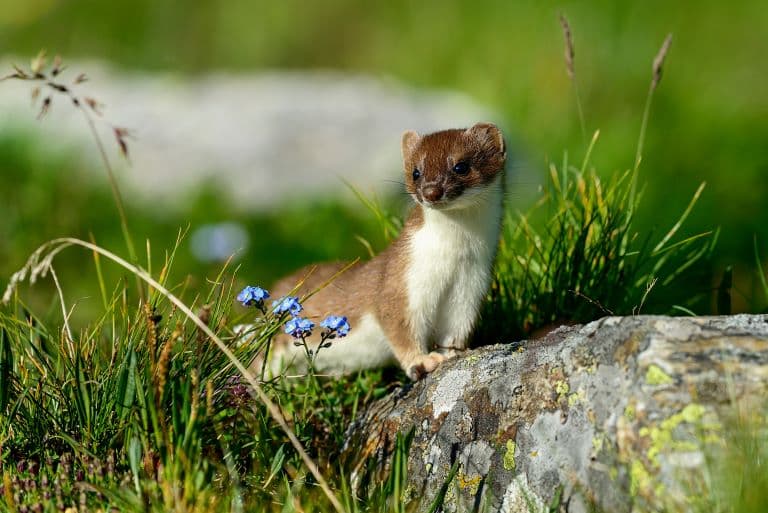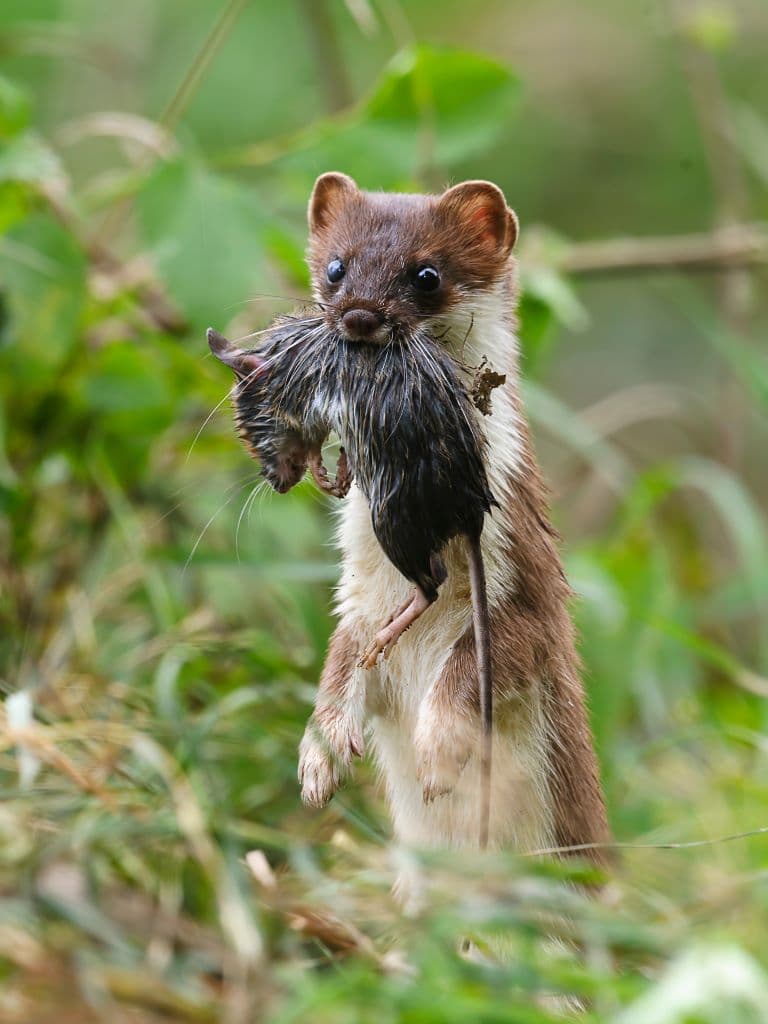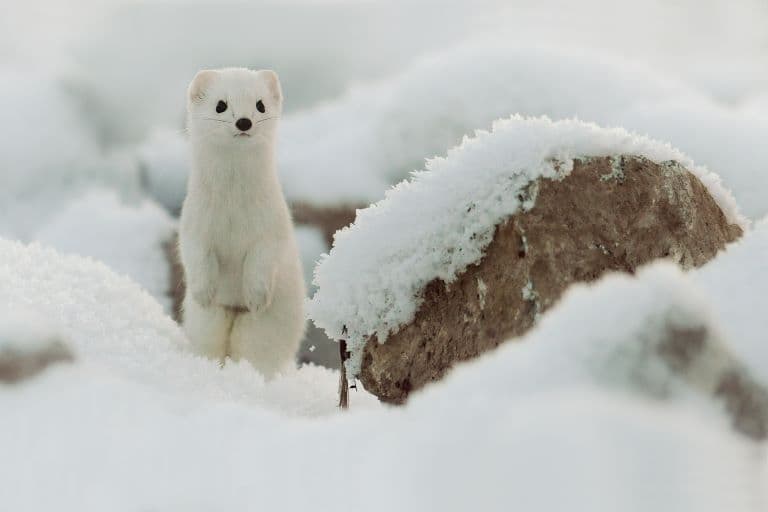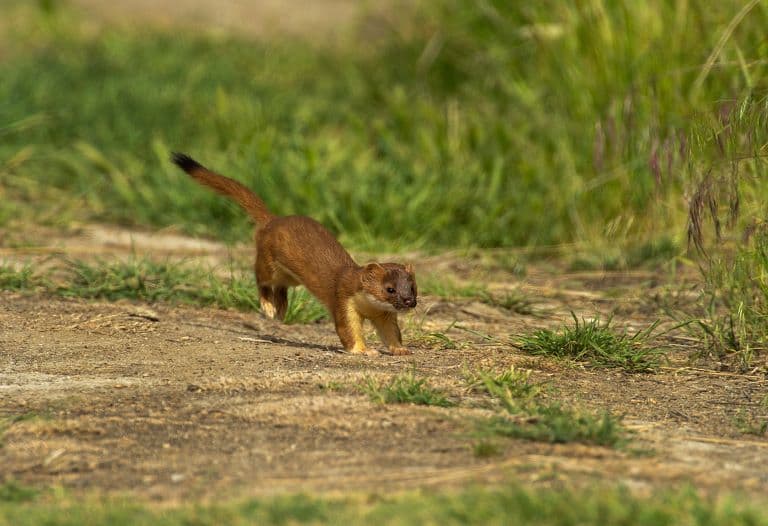Stoat Profile
Mustelids are a topic that deserves to become repetitive. This diverse family of carnivores contains some of the toughest animals around and the most terrifying predators for anything up to five times their size. This family contains the well-known badgers and otters, but also a plethora of smaller, elongated terrors from the weasel genus Mustela.
These are the weasels, polecats stoats, or ermines, and they deserve to be represented!

Stoat Facts Overview
| Habitat: | Mostly wooded, some coastal, open areas next to woodland |
| Location: | Circumpolar, North America and Eurasia |
| Lifespan: | Up to 7 years |
| Size: | Up to 4cm (15 inch) body length |
| Weight: | Up to 400g (0.9 lb) |
| Colour: | Brown to black, white in winter |
| Diet: | Rodents, hares, waterfowl, eggs, fish, insects, lizards, snakes |
| Predators: | Larger mammalian predators, raptors |
| Top Speed: | 20 km/h |
| No. of Species: | 3 |
| Conservation Status: | Least Concern |
Stoats are members of the weasel genus, though twice as large as the smallest species they’re far from the largest, yet what they lack in size, they make up for in tenacity. They are formidable, intelligent, all-terrain predators and can handle climates and locations few people would bear.
Unfortunately, they are so good at what they do that they cause tremendous damage to the ecosystems they are introduced to.
Interesting Stoat Facts
1. They’re bold weasels
Stoats aren’t the largest in the Mustela genus, they’re significantly smaller than polecats, for example, but they’re quite a lot bigger than the smallest, the least weasels at around twice the weight.
Stoats were once grouped into a single species, Mustela erminea, but from this group, two other species have been identified, the American ermine, M. richardsonii and the Haida ermine, M. haidarum, both of whom from North America.
The word stoat likely comes from the Dutch for “bold” and this is a great descriptor for all Mustela m embers. The other name, ermine, possibly comes from “Armenian mouse”, which is a bit of an insult to the stoat, even with mice being as amazing as they are.
2. They’re excellent predators
Stoats are incredible hunters, capable of following prey into the water, up trees, or underground. Unless you’re a bird, there’s very little chance you can escape a hungry stoat and even animals with incredible speed, like hares, can be chased to exhaustion and then despatched.
And a hare may be five times the size of a stoat. Stoats kill with a powerful piercing bite to the neck or skull, much like jaguars do, and they’ll kill almost anything they can. 1 2

3. But they’re not born this way
It takes a little while for a stoat to grow into its role, and, like humans, they’re born absolutely useless. They have barely any hair, they can’t see, and they’re altogether rubbish but they are dangerously cute, and as soon they get moving, they’re playful little bundles of joy.
Mothers look after the young, and babies have a convenient little fur patch on the neck that acts as a handle for mum to grab hold of when moving her babies.
Unlike humans, it doesn’t take them long to become awesome, and baby stoats are out with their mothers, killing animals with their teeth within 8 weeks of being born. 3
4. They become pure white in the Winter
Stoats go through a dramatic transformation when Winter comes along. Following the fashion of the season, their dark fur gives way to a stunning pelt of bright white. This is exceptional camouflage and simply makes them cuter by contrasting their dark eyes and noses against their snowy fur.
Many keep the black tip on the tail, which may function as an eye spot, distracting predators of the stoat away from its vital organs and sensitive face. 4

5. They can run
There’s not much chance of outrunning a stoat. Their incredible stamina, agility and toughness allow them to keep up with many prey animals and they will happily enter tunnels and burrows of prey, sometimes even raiding fox dens to steal pups.
Rabbits make up much of the stoat’s diet, and so warrens are frequently threatened by the mustelids. Nests in trees are not safe, nor are shallow waters, where fish may also be taken.
When hunting, they follow a zig-zag pattern, systematically covering the ground, sometimes doing this for several hours, covering a couple of kilometres from the den. It’s said they can run up to 32 km/h.
When a victim is found in a burrow, it’s killed swiftly and its old home is occupied by the stoat. A successful stoat will have multiple burrows active at once, and stoats will often be seen ‘celebrating’ a kill with a “weasel war dance”.
There’s a myth that this dance is used to hypnotise their prey, and while this is almost certainly nonsense, the true reason stoats (and other weasels) dance like this is unclear. 5

6. They have a long birthing calendar
Males mature quickly in stoats, after about a year. Females take a couple of years more, and after mating it will be the best part of 10 months before she gives birth. Four to seven babies will be birthed, but this extremely long gestation is a product of delayed development.
The stoat can slow the development of the young through rough seasons, timing their births when food is plentiful. Development can be delayed for 8 to 9 months, depending on the conditions.
7. They’re the worst invaders
It’s no surprise that these little mustelids are a force to be reckoned with in areas in which they are introduced.
New Zealand ecosystems have had some astoundingly bad luck with invaders, and stoats are certainly one of the worst. Stoats prey on kiwis, parakeets, terns, and various other unique species, many of which are already endangered.
But it’s not just birds, local lizards, insects, crayfish and more or less any animal in any biome is in danger from one of the world’s toughest and most versatile predators.
Stoat Fact-File Summary
Scientific Classification
| Kingdom: | Animalia |
| Phylum: | Chordata |
| Class: | Mammalia |
| Order: | Carnivora |
| Family: | Mustelidae |
| Genus: | Mustela |
| Species: | erminea, richardsonii, haidarum |
Fact Sources & References
- “STOAT”, Woodland Trust.
- “Mustela erminea ermine”, Animal Diversity Web.
- “Stoat and weasel”, NatureScot.
- (2022), “THE WHITE WEASELS OF WINTER”, Alliance for the Chesapeake Bay.
- “Alliance for the Stoat – Mustela erminea”, Saving Britain’s Wildlife.
